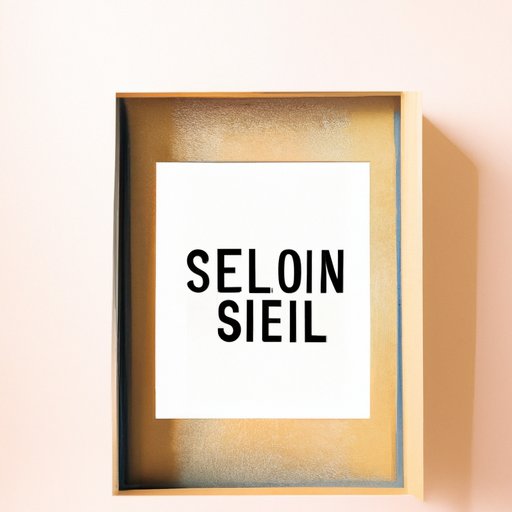
Introduction
Selling art online has become an increasingly popular way for artists to bring their work to a global audience and make a profit. With so many online platforms available, it can be overwhelming for artists to know where to start. However, with the right strategies and tactics, it is possible to successfully sell art online and maximize profits. This article aims to provide a comprehensive guide for artists looking to sell their artwork online, covering everything from social media marketing to pricing strategies.
10 Tips for Selling Your Art Online and Making a Profit
1. Build a Social Media Presence: Social media platforms like Instagram and TikTok are great tools for artists to showcase their work and connect with potential buyers. By posting high-quality photos and videos of your artwork, you can build a loyal following and increase your online visibility.
2. Create an Online Store: Setting up an online store is an essential step for artists looking to sell their artwork online. Platforms like Etsy, Shopify, and Squarespace allow artists to create professional-looking stores that are easy for buyers to navigate.
3. Optimize Product Photos: High-quality product photos are essential for making a good impression on potential buyers. Make sure your photos are well-lit, accurately represent the artwork, and have a clean backdrop.
4. Offer Promotions: Providing incentives like discounts and free shipping can help attract buyers and encourage repeat business.
5. Get Involved in the Online Art Community: Engaging with other artists and collectors online can help increase your visibility and establish yourself as a serious artist.
6. Use Email Marketing: Building an email list of interested buyers allows you to keep them updated about your work and offerings.
7. Host Live Sales: Platforms like Facebook and Instagram Live offer an opportunity for artists to showcase their work and interact with potential buyers in real-time.
8. Collaborate with Other Artists: Collaborating with other artists or creatives can help expand your audience and generate excitement around your work.
9. Attend Virtual Art Fairs: Virtual art fairs have become increasingly popular in recent years, providing artists with an opportunity to showcase their work to a global audience.
10. Create a Blog: Blogging about your work and process can help establish yourself as an expert in your field and attract potential buyers.
How to Maximize Your Profits When Selling Art Online
When it comes to making a profit selling art online, there are several strategies that artists can use:
1. Set Your Prices Strategically: One approach to pricing artwork is to set prices based on the time, materials, and expertise involved in creating the piece. Alternatively, some artists prefer to price based on the perceived value to the buyer. No matter what your pricing strategy, it’s important to research your market and competitors to make sure your artwork is priced fairly.
2. Offer Bundling Options: Offering discounts for multiple purchases can incentivize buyers to purchase more than one piece of art at a time.
3. Minimize Overhead Costs: By minimizing the costs associated with creating and shipping artwork, artists can maximize their profits. For example, using high-quality but affordable materials and negotiating shipping rates with carriers can help keep costs down.
The Benefits of Selling Art Online vs. In-Person
While there are certainly advantages to selling art in-person, selling online offers a number of benefits as well:
1. Reach a Broader Audience: By selling artwork online, artists can reach a global audience rather than being limited to their local community.
2. Convenience: Selling art online allows artists to sell from anywhere with an internet connection, rather than having to physically be present.
3. Increased Flexibility: Online platforms like Etsy and Shopify allow artists to set their own schedules and work on their own terms.
By taking advantage of these benefits, artists can maximize their online sales and grow their businesses.
Using Social Media to Sell Your Art: A Comprehensive Guide
Social media platforms like Instagram and Facebook offer a powerful way for artists to promote and sell their work. Here are some best practices for each platform:
1. Instagram: To promote your work on Instagram, make sure to use relevant hashtags, post high-quality images, and engage with other users by commenting and liking their posts.
2. TikTok: With its short-form video format, TikTok offers a fun and creative way for artists to showcase their work. To gain traction on the platform, consider creating tutorials or showing your process.
3. Facebook: Facebook is a great platform for hosting virtual events such as art auctions or live sales. Make sure to also join Facebook groups related to art to network and connect with potential buyers.
Building a Successful Online Art Business: Lessons from Top Sellers
Interviews with successful artists can provide valuable insights and strategies for building a thriving online art business. Here are some key takeaways:
1. Building a Loyal Customer Base: By prioritizing customer service and providing a high-quality product, artists can build a loyal following and generate repeat business.
2. Staying up-to-date with Trends: Keeping up with the latest trends in the art world can help artists stay relevant and attract new customers.
3. Balancing Creativity with Business Savvy: Managing an online art business requires both artistic talent and business acumen. Successful artists find a balance between pursuing their creative vision and staying on top of the day-to-day logistics of running a business.
Conclusion
Selling art online can be a rewarding and profitable venture for artists willing to put in the time and effort. By following best practices for social media marketing, pricing, and customer service, artists can increase their online visibility and maximize profits. By taking advantage of the benefits of selling online, artists can reach a global audience and grow their businesses. Remember to stay up-to-date with trends and strategies for success, and don’t be afraid to experiment and try new approaches. The online art market is constantly evolving, so persistence and adaptability are key.




